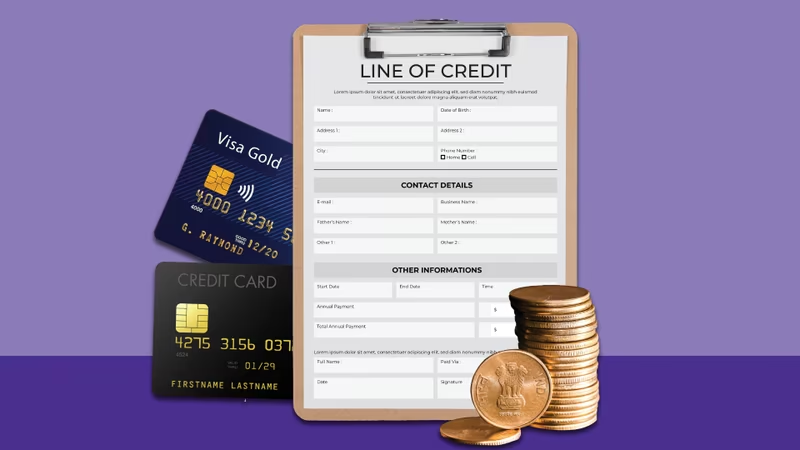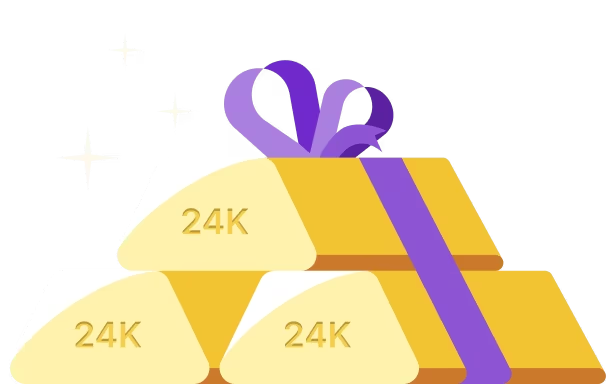In times of financial crisis, people often require immediate funds to address their situation. To fulfill this need, banks and financial institutions offer loans that provide financial assistance during such times.
However, the conventional lending system has limitations. Banks maintain a minimum loan threshold, meaning borrowers might have to borrow more than they need due to this limit.
For instance, if you need only Rs. 15,000 but the bank's minimum loan amount is Rs. 50,000, you will be compelled to borrow a more significant sum.
The primary issue in this scenario is the substantial interest payment the borrower has to make monthly.
Even if only a portion of the loan is used, the bank applies interest to the borrowed amount, leading to excessive interest payments and exacerbating cash flow problems.
To address this concern, banks have introduced the "Line of Credit." This approach allows you to withdraw the required amount from an approved loan limit, and interest is applied solely to the withdrawn sum.
This minimizes unnecessary interest expenses and provides a more flexible borrowing solution.
In this article, we will look at everything you need about a line of credit.
Line of Credit Meaning
A line of credit (LOC) is a mutual agreement between a borrower and a lender, a bank or a non-banking financial company (NBFC).
This line of credit meaning implies that within this arrangement, the lender commits to granting the borrower access to a maximum fund amount.
As required, the borrower can withdraw money, sticking to the set limit. Line of credit Interest is only levied on the borrowed sum, not the overall limit, resulting in a significant advantage.
Unlike a conventional loan that provides a lump sum, a line of credit permits borrowing within a predetermined limit. Its usefulness extends to short-term financial needs or extended undertakings, such as business funding or home improvements.
A line of Credit signifies a predetermined borrowing entry that a bank offers for the borrower's use, with the option for repeated borrowing in an open line of credit.
Interest accrues solely on the withdrawn sum, facilitating superior management of monthly expenditures.
Generally, the Line of credit interest rate is lower than traditional loans.
For instance, if a bank sanctions Rs.80,000 and the borrower takes out Rs.15,000, interest is calculated on the borrowed Rs.15,000, excluding the remaining amount.
A line of credit extends to individuals, businesses, or governments through financial institutions. It offers flexibility wherein borrowers can get a line of credit from the sanctioned credit limit based on their requirements.
Financial reliability determines eligibility, and you only pay interest on the portion you use. You can think of a line of credit as a reservoir of potential funds that can be borrowed, akin to a credit card without a tangible card.
Types of Line of Credit
There are typically two types of lines of credit: secured and unsecured. Let's delve into these distinctions:
1. Secured Line of Credit
A secured line of credit involves borrowing against collateral, with assets at risk if repayment fails. This line of credit loan offers lower interest rates due to asset security and factors like the borrower's income and credit score. Various secured lines of credit in India include:
- Home Equity
- CD-backed
- Securities-Backed options.
2. Unsecured line of credit
An unsecured line of credit also referred to as a revolving credit account, is granted by a financial institution based on an individual's credit score and income.
No collateral is required for this credit option, but the interest rate is elevated due to the absence of pledged assets.
The interest rate for this type of Line of credit is higher than that of secured Line credit.
Since it lacks collateral, the repayment risk is relatively more significant, resulting in a higher interest rate.
Variations of Unsecured LOC
1. Personal Line of Credit
This revolving credit type allows you to borrow funds when necessary, up to a predetermined limit. It's similar to a credit card but frequently provides better interest rates and increased credit limits.
Borrowers can withdraw money as needed within the approved limit, with interest applied solely to the borrowed amount, not the entire limit. Repaying the borrowed sum restores the available credit for future use.
2. Business Line of Credit
This financing option provides access to a set amount of capital for occasional business use.
Similar to personal lines of credit, businesses can borrow funds as required, up to their approved limit. Interest applies only to the borrowed amount, and repaying it replenishes the available credit.
3. Demand Line of Credit:
A Demand Line of Credit is a flexible borrowing option where you can access funds you need without a fixed repayment schedule. It's often used in businesses, allowing quick access to funds for various needs, and repayment terms are more adaptable than traditional loans.
How can you use a line of credit
To take advantage of a Line of Credit (LOC) wisely, you must maximize its benefits while avoiding pitfalls.
Like a credit card, a Line of credit can be a valuable tool if you manage it responsibly. To make the most of it, you must exhibit financial discipline and guarantee repayment capability.
To apply for a LOC, eligibility factors such as a good CIBIL score (preferably over 750) and a stable income are assessed by a service provider or financial institution. Once approved, a "draw period" is established, allowing the borrower to withdraw funds from the LOC account via card, cheque, or transfer.
During this draw period, interest accumulates on the withdrawn amount. Repayments made are added back to the LOC account. After the draw period concludes, the repayment period commences.
The borrower is accountable for paying back the remaining credit.
Let's see if LOC impacts Credit Score.
Impact of Line of credit on credit score
A LOC influences your credit score significantly. When you make punctual payments, it enhances your credit score and history, which results in positive growth.
Conversely, failure to meet repayment deadlines has a negative effect, causing your credit score to decline.
Now let's see what revolving and non-revolving line of credit is.
Revolving line of credit
Revolving credit is simply a line of credit loan that can be used repeatedly, providing access to a specific amount of funds without needing to reapply.
Examples include personal lines of credit, home equity lines of credit (HELOCs), credit cards etc.
It's often called open-ended credit or an unsecured loan. With revolving credit, you can borrow up to a defined credit limit and carry a balance from month to month.
While paying in full avoids monthly payments and interest, more significant balances lead to higher payments and charges.
Repayment is flexible, there's no fixed end date, and funds remain accessible as long as the account is in good standing.
Non-revolving Line of credit
Non-revolving line of credit loan pertains to a one-time settlement of debts, seen in examples like student loans, personal loans, and mortgages.
Unlike revolving credit, which allows a continuous expansion of debt limits, non-revolving credit involves a fixed sum that remains constant upon full repayment. Once the loan is settled, no further obligation exists to the lender.
Limitations of Line of credit
Borrowers must understand the limitations associated with a line of credit in India.
Here are some restrictions to carefully consider before obtaining a line of credit:
- Unsecured lines of credit loans in India often come with elevated interest rates and strict credit requirements.
- Interest rates on these credit lines tend to be variable, differing between various Indian financial institutions.
- Regulatory safeguards provided for lines of credit and credit cards are not necessarily equivalent. Noncompliance, like late payments or surpassing the credit limit, can lead to substantial penalties.
- Opting for an open line of credit could result in overspending and difficulties honouring payment commitments.
- Misusing a line of credit in India can detrimentally affect an individual's credit score, an issue worth considering.
Depending on the severity of the situation, exploring reputable credit card services in India might be advisable.
Line of Credit vs Loan
A line of credit offers access to a specific fund amount without reapplying, allowing multiple uses like credit cards or HELOCs. In contrast, a "loan" settles debts at once, seen in student loans or mortgages.
Line of Credit VS Credit card
A line of credit is comparable to a credit card but typically offers more favourable interest rates and higher credit ceilings when compared to a traditional credit card.
If you want to estimate your potential credit limits and payments, you can use a line of credit calculator to get a clearer picture of your financial options.
Conclusion
A Line of Credit loan can be effectively used by sticking to responsible financial practices, utilizing the draw period wisely, making timely repayments, and being mindful of the interest accrued.
Remember, responsible use is essential to avoid accumulating excessive debt.
Always repay what you borrow, and be mindful of interest rates and terms.










